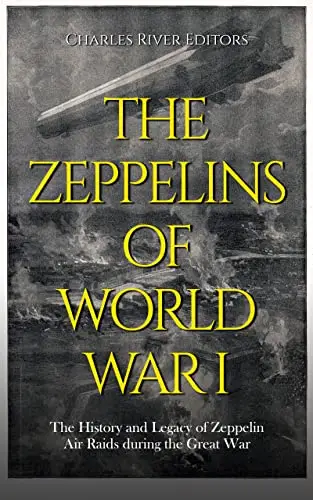The Zeppelins of World War I: The History and Legacy of Zeppelin Air Raids during the Great War by Charles River Editors
English | December 1, 2021 | ISBN: N/A | ASIN: B09MYL6YTN | 75 pages | EPUB | 2.41 Mb
English | December 1, 2021 | ISBN: N/A | ASIN: B09MYL6YTN | 75 pages | EPUB | 2.41 Mb
*Includes pictures
*Includes a bibliography for further reading
*Includes a table of contents
World War I, also known in its time as the Great War or the War to End all Wars, was an unprecedented conflict in terms of its sheer scale. Fought by men who hailed from all corners of the globe, it saw millions of soldiers do battle in brutal assaults of attrition which dragged on for months with little to no respite. Tens of millions of artillery shells and untold hundreds of millions of rifle and machine gun bullets were fired in a conflict that demonstrated man’s capacity to kill each other on a heretofore unprecedented scale, and as always, such a war brought about technological innovation at a rate that made the boom of the Industrial Revolution seem stagnant.
Since the Industrial Revolution, arms and materiel output had increased by orders of magnitude, as had the quality and uniformity of the products. Several developments had already taken place in the years building up to the conflict, steppingstones towards the vast escalation in military innovation which took place immediately prior to and during World War I.
The arms race before the war and the attempt to break the deadlock of the Western and Eastern Fronts by any means possible changed the face of battle in ways that would have previously been deemed unthinkable. Before 1914, flying machines were objects of public curiosity; the first flights of any account on rotor aircraft had been made less than 5 years before and were considered to be the province of daredevils and lunatics. By 1918, all the major belligerents were fielding squadrons of fighting aircraft armed with machine-guns and bombs, to say nothing of light reconnaissance planes.
While airplanes had never before appeared above the field of war, other aerial vehicles had already been in use for decades, and balloons had carried soldiers above the landscape for centuries to provide a high observation point superior to most geological features. The French used a balloon for this purpose at the Battle of Fleurus in 1794, and by the American Civil War, military hydrogen balloons saw frequent use, filled from wagons generating hydrogen from iron filings and sulfuric acid.
In fact, with advances in dirigible technology, many military thinkers and even aeronautical enthusiasts believed that blimps would remain the chief military aerial asset for the foreseeable future. These men thought airplanes would play a secondary role at best and might even prove a uselessly expensive gimmick soon to fade back into obscurity, leaving the majestic bulk of the dirigible as sole master of the skies.
The Zeppelins, slow and large as they were, proved to be easy targets for fire from the ground, so they were too vulnerable for reconnaissance in the warzone. Instead, they were used for the task of bombing targets. Bombs were dropped on Paris in August 1914, and Zeppelins bombed Belgian forces as the Germans advanced on Liège. The Germans also used them to bomb England’s eastern ports and London in an attempt to disrupt military supplies. On the other side, British pilots destroyed a Zeppelin on the ground at Düsseldorf.
This was bombing at its most simple; the explosives were kept on hooks on the side of the machines and dropped by a crew member by hand. These small forays into aerial bombardment barely even hinted at the bombing campaigns to come, but Zeppelin raids on Britain would continue for nearly four years, killing more than 500 people and injuring 1,300. These raids and the attempts to stop them would be carried out at the cutting edge of new technology.
Feel Free to contact me for book requests, informations or feedbacks.
Without You And Your Support We Can’t Continue
Thanks For Buying Premium From My Links For Support
Without You And Your Support We Can’t Continue
Thanks For Buying Premium From My Links For Support



